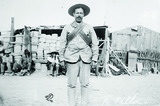
Amidst tensions over European political and territorial boundaries, the assassination of Archduke Franz Ferdinand by a Serbian terrorist in 1914 derailed peace in the western world by sparking World War Ione of the highest-casualty conflicts in modern times. While European nations quickly engaged, the United States immediately declared neutrality. By 1917, however, remaining neutral was no longer an option. The Great War would bring the United States out of isolationism and onto the world stage. It would also change life on the American home front forever. A centralized government took control of American life in an unprecedented fashion by instating a mandatory military draft, controlling industries, initiating food and ration restrictions, and launching elaborate campaigns to encourage patriotism. One of the most important, if temporary, changes brought by the war at home came from the stifled flow of labor, as men were pulled away by the draft and immigration slowed. The need for American labor provided second-class citizens, such as women and African Americans, a brief opportunity for better jobs. This glimpse would help foment in them a desire for more and equal opportunities after they were pulled away once more at wars end. This exhibition was created as part of the DPLAs Public Library Partnerships Project by collaborators from Digital Commonwealth. Exhibition organizer: Anna Fahey-Flynn.
- Subject:
- History
- U.S. History
- Material Type:
- Diagram/Illustration
- Primary Source
- Unit of Study
- Provider:
- Digital Public Library of America
- Provider Set:
- DPLA Exhibitions
- Author:
- Anna Fahey-Flynn
- Date Added:
- 09/01/2015


